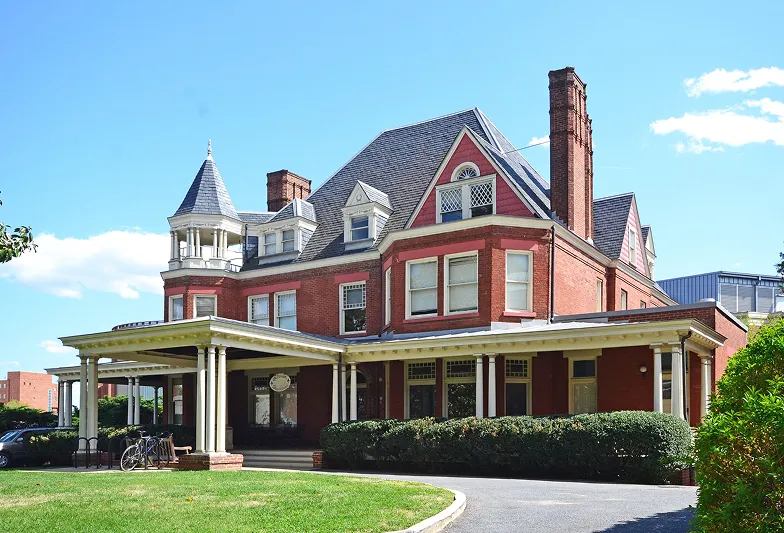At Commonwealth Contractors, our approach to building mirrors my personal philosophy on life, blending practicality with a touch of ingenuity. With a deep respect for classical building principles and a keen eye for modern improvements, you can rest assured that when you collaborate with Commonwealth Contractors, your project will be managed with quality and integrity.
.svg)


Think your kitchen could use an upgrade? You're not alone. The kitchen is more than just a place to cook; it's a central hub for many activities. And when it comes to making significant changes, most homeowners prefer to lean on experts. In fact, in 2021, nearly 9 in 10 homeowners (89%) chose to rely on professionals for their kitchen remodels.

It's clear that when it comes to something as central as the kitchen, expertise matters. At Commonwealth Contractors, we're proud to be among the specialists that homeowners trust in Virginia. With 2024 upon us, the trend towards efficient and cost-effective kitchen remodels continues to grow.
So, where should you begin? Crafting a detailed kitchen remodel timeline is key. It not only sets the pace but also ensures every detail is considered, from budgeting to final touches. This article introduces a comprehensive kitchen remodel checklist that's designed to help you stay on track.
Ready to transform your kitchen? Let's dive in.
A Kitchen Remodel Timeline Checklist
It’s easy to get caught up in those first 2-4 weeks of planning your kitchen renovation. During this exciting phase, you get to dream big and find that awesome contractor who just gets it. Do it right, and you'll end up with a kitchen that feels like "you" in every way.
Below is a detailed step-by-step checklist designed to help you navigate your kitchen remodel timeline effectively:
1. Set a Kitchen Remodeling Budget
A well-planned budget is your ticket to transforming your kitchen without financial stress. By aligning your vision with realistic costs early on, you ensure every decision is both wise and impactful.
- Financial Planning: Your budget should be a reflection of your vision. Consider following HGTV’s 10 steps to a successful kitchen remodel budget.
- Unexpected Expenses: Always have a buffer in your budget. Unforeseen costs can arise, and it's wise to be prepared.
- Smart Spending: Direct your funds towards areas that will significantly enhance the look and feel of your kitchen. It's about getting the most bang for your buck.
- Market Research: Knowledge is power. Familiarize yourself with the current market rates for materials and services to ensure you're not overpaying.

Kitchen Remodel Cost Breakdown
While each kitchen renovation is unique, influenced by material choices, design intricacies, and personal vision, there are common financial benchmarks to consider. On average, a kitchen remodel can range from $12,000 to $60,500, everything from minor touch-ups in smaller spaces to extensive overhauls in larger kitchens.
Here's a breakdown of common expenses you might encounter throughout your kitchen remodel timeline:
- Countertops ($10-$200 per square foot): Countertop costs vary based on material choice, influencing your kitchen's appearance and durability.
- Cabinets ($3,000-$8,000 for standard cabinets): Cabinets are foundational to kitchen design; prices depend on factors like wood type, finishes, and customizations.
- Appliances ($400-$9,000+ depending on brands and features): Appliance costs vary with brand and features, align your choice with function and budget.
- Lighting ($200-$500 for the entire kitchen): Lighting fixtures, including ceiling, under-cabinet, and pendant lights, impact both ambiance and function.
- Flooring ($3-$10 per square foot): Flooring choices like hardwood, tile, vinyl, or laminate affect your kitchen's look and may incur extra costs for repairs or premium materials.
- Plumbing ($1,000-$3,000): Plumbing expenses may arise from sink or faucet relocations and unforeseen issues.
- Electrical ($1,000-$3,000): Electrical work includes rewiring and lighting installation; extra costs could emerge for system upgrades.
- Backsplash ($800-$2,500): Backsplash expenses vary by material and complexity; intricate designs may incur additional costs.
Kitchen Remodel Additional Costs
Besides the main costs, there are unexpected ones that can pop up. These aren't just extras—some are set by local rules, or tied to project details and your design choices. To smoothly shift from your old kitchen to your dream one, it's smart to know these costs upfront. Here's a peek at some additional expenses you might run into:
- Permits and Inspections ($100-$1,000+): Fees are location-dependent and based on project extent. Delays in obtaining kitchen remodel permits can extend your kitchen remodel timeline.
- Labor Costs (15%-25% of the total budget): Labor expenses, contingent on complexity and local rates, may rise due to unforeseen issues or design changes.
- Contingency Fund (10%-20% of the total budget): A contingency fund covers unforeseen expenses or design alterations during the remodel.
- Decor and Furnishing ($1,000-$5,000+): Budget for decor elements like paint, window treatments, and furnishings to complete your kitchen's aesthetics.
2. Visualize Your Dream Kitchen
To visualize your dream kitchen, delve into design resources for style inspiration, prioritize essential appliances for functionality, and consider layout and features for optimal comfort.
Aesthetics
Whether it's modern, traditional, or farmhouse, your style choice will set the tone for the entire project. Get inspired! Check out these 2023 kitchen remodel trends.
1. Modern Style

- Characteristics: Sleek, minimalistic design, with flat-panel cabinets, frameless construction, and a focus on horizontal lines.
- Materials: Stainless steel, lacquered cabinets, glass, and composite materials.
- Color Palette: Neutral colors, often with bold contrasts.
- Resources: Check out this modern kitchen styles inspiration board
2. Traditional Style

- Characteristics: Elegant, classic design with detailed moldings and trim, raised-panel cabinets, and decorative lighting.
- Materials: Wood (like cherry, maple), natural stone countertops, classic hardware.
- Color Palette: Warm, inviting colors.
- Resources: Check out this traditional kitchen styles inspiration board
3. Farmhouse Style

- Characteristics: Cozy, rustic charm with open shelving, a large kitchen sink (often apron-front), and a mix of old and new elements.
- Materials: Reclaimed wood, butcher block countertops, brick backsplash.
- Color Palette: Earthy tones, soft whites, and pastels.
- Resources: Check out this farmhouse kitchen styles inspiration board
4. Industrial Style

- Characteristics: Raw, unfinished look with exposed pipes and ducts, open shelving, and a mix of wood and metal.
- Materials: Stainless steel, concrete countertops, exposed brick.
- Color Palette: Neutral with metal accents.
- Resources: Check out this industrial kitchen styles inspiration board
Functionality
Think about the essential features and appliances that will make your kitchen both beautiful and practical. Assess opportunities for custom space saving functionality such as:
Pull-Out Pantries
Slim, vertical pull-out cabinets or pantries are perfect for narrow spaces. They can store spices, canned goods, and other small items, making them easily accessible while saving space.
Corner Drawer
Innovative corner drawer designs can utilize the often-wasted space in corner cabinets. These drawers pull out diagonally, providing ample storage for pots, pans, or dishes.
Hanging Pot Rack
Install a hanging pot rack above the kitchen island or against a wall. This frees up cabinet space and keeps pots and pans within easy reach.

Magnetic Knife Strips
Instead of a bulky knife block, use a magnetic strip mounted on the wall to store knives. This saves counter space and keeps knives easily accessible.
Fold-Down Tables
A fold-down table mounted on a wall can serve as an extra prep area or dining space. When not in use, it can be folded down to save space.
Integrated Appliances
Opt for integrated appliances that can be built into the cabinetry. This includes refrigerators, dishwashers, and microwaves, creating a seamless and space-efficient look.

Built-In Seating
Incorporate built-in benches or banquettes, which can offer hidden storage underneath and eliminate the need for bulky chairs.
User Experience
The flow of the kitchen is crucial. Ensure it's user-friendly, optimizing spaces for cooking, dining, and socializing.
Listing Must-Haves
Jot down the appliances and features you can't do without. Maybe it's a double oven for those big family dinners or a spacious island for your baking projects.
3. Prepare to Survive without a Kitchen
It will be tough not having your usual kitchen set-up during a makeover. Preparing for this change is key to keeping your daily life ticking along without too many hiccups. Here's what to keep in mind:
- Minimize Disruptions: Seal off work areas to prevent dust and noise from spreading to other parts of your home.
- Temporary Kitchen Setup: Possibly designate a makeshift kitchen in a spare room or garage with basic appliances?
- Stock Up on Essentials: Ensure you have non-perishable foods and disposable utensils for easy meal preparation.
- Meal Planning: Plan simple, one-pot meals and consider takeout options for convenience.
- Contingency Planning: Be flexible with gas line rerouting and appliance deliveries, and create temporary storage space for materials and appliances.
4. Anticipate Potential Obstacles
It's always great to be a step ahead in any endeavor. By spotting potential challenges early, not only can you better manage your time and budget, but you'll also reduce stress and make more informed decisions. Here are key considerations:
- Component Reuse: Evaluate whether existing components like hood vent pipes or wiring can be reused to reduce costs and complexity.
- Energy Source Compatibility: Check if new appliances align with existing energy sources, and determine if gas lines need to be rerouted for safety and functionality.
- Dimension Compatibility: Confirm that the dimensions of new appliances allow for smooth passage through doorways to avoid logistical challenges.
- Storage Planning: Arrange for adequate storage space in your garage or home to keep materials and appliances safe and organized until installation.
5. Line Up a Contractor
A truly great contractor will not only have a solid reputation but will also understand and share in the excitement of your renovation journey. Here's what you should consider:
- Personal Connection: Look for a contractor that genuinely gets your vision and displays enthusiasm about making it a reality.
- Early Engagement: Begin your search early. This gives you time to find someone who resonates with your aspirations and ensures they're available when you need them.
- Expect the Unexpected: Even with the best-laid plans, hiccups can occur. Factor in some buffer time to your project to cater to any unforeseen changes or tweaks.
- Open Conversations: Ensure you're on the same page regarding budget and design from the outset. A contractor in tune with your dream will offer clarity and might even suggest ways to enhance your initial ideas.
Unraveling Your Kitchen Remodel Timeline
The construction phase of a kitchen remodel timeline typically spans between 6 to 12 weeks. However, the actual duration can vary depending on several factors, with the project's complexity being a primary determinant. Let's break down the construction process into key phases:

Planning and Design (1-2 weeks)
During this initial stage, the focus is on finalizing your kitchen design, layout, and material choices. It involves consultations with your contractor, decision-making on style and functionality, and the creation of detailed plans.
- Space Utilization: Design according to your daily routines for maximum efficiency.
- Storage: Incorporate cabinets, drawers, and possibly a pantry for a clutter-free kitchen.
- Workflow: Consider the "kitchen triangle" of sink, stove, and refrigerator for optimal movement.
- Island or No Island: Decide if an island fits your space and needs.
Material Ordering and Delivery (3-5 weeks)
Selecting the right materials is a pivotal step in bringing your dream kitchen to life. From elegant countertops to versatile cabinets and energy-efficient appliances, these choices not only impact aesthetics but also the overall functionality of your kitchen space. The timeline for this phase depends on material availability and potential custom orders.
- Countertops: Choose from materials like granite, quartz, or laminate based on budget and style.
- Cabinets: Decide between wood, laminate, or metal finishes.
- Appliances: Consider energy-efficient options for long-term savings.
- Lighting: Opt for LED lights that match your kitchen's aesthetic.
Demolition (1 week)
Once the materials are secured, the existing kitchen undergoes demolition. This phase involves the removal of old cabinets, countertops, flooring, and appliances. While typically taking around a week, the duration can vary based on the extent of demolition needed.
- Safety First: Always ensure the workspace is secure, turning off utilities and ensuring any hazardous materials are handled appropriately.
- Recycle or Donate: Consider donating usable items like old cabinets or appliances to local charities or repurposing them elsewhere.
- Expect Dust: Demolition can get messy. It's a good idea to seal off the area during the demolition phase to prevent dust and debris from spreading to other parts of your home.
- Daily Clean-Up: A tidy demolition site at the end of each day can reduce hazards and make the entire process smoother.
Installation and Building (3-6 weeks)
This phase represents the core transformation of the kitchen space. The following outlines what typically happens:
- Sequential Process: Installations typically proceed in a specific order, starting with foundational elements like electrical and plumbing, followed by structural components like cabinets and countertops.
- Quality Assurance: Every step of the installation is checked against quality benchmarks to ensure the final output meets design and durability standards.
- Adaptive Modifications: As various elements come together, some adjustments may be necessary due to unforeseen spatial or compatibility issues.
- Ongoing Communication: Throughout this phase, there's a continuous exchange of updates, feedback, and clarifications between contractors and designers to align with the project's vision.
Final Touches (1 week)
This stage brings the kitchen remodel to its polished conclusion. Here's what it involves:
- Aesthetic Enhancements: Painting and backsplash installations occur at this stage, amplifying the visual appeal of the space.
- Cabinet Refinement: Finishing touches to cabinets, like adding handles, knobs, or final sealing, ensure both functionality and elegance.
- Operational Verification: All installed components, from appliances to fixtures, undergo checks to confirm they function as intended.
- Fine-Tuning: Any minor adjustments or corrections are made to perfect the overall appearance and functionality of the remodeled kitchen.
Why Choose Commonwealth Contractors for Your Next Kitchen Remodel?
Imagine walking into your kitchen every morning, the sunlight streaming in, highlighting every detail you've dreamt of. The countertops gleaming, the cabinets perfectly aligned, and the aroma of your morning coffee filling the air. This dream can either become a reality or remain a distant wish based on one crucial decision: the contractor you choose.

Commonwealth Contractors isn't just another name in the industry. Here's why:
Expertise and Experience
At Commonwealth Contractors, we boast years of experience in the construction and remodeling industry. This ensures that we bring a wealth of knowledge and skill to every project we undertake.
Structured Approach
Our systematic approach to every project, from initial planning to execution, guarantees meticulous attention to detail and a smooth remodeling process.
Transparent Communication
Our use of the Buildertrend management system is a testament to our commitment to transparency. We keep our clients informed at every stage, providing regular updates, daily reports, and direct communication channels.
Client-Centric Approach
At Commonwealth Contractors, we place a strong emphasis on understanding and prioritizing the unique needs and visions of our clients. This commitment ensures that every remodel is tailored to the client's preferences and lifestyle.
Budget Management
Financial planning and budgeting are cornerstones of our approach. We work closely with clients to set and manage realistic budgets, ensuring efficient resource allocation and value for money.
Quality Assurance
Our unwavering commitment to quality means that we source only the best materials and ensure top-notch craftsmanship in every project. This dedication guarantees that the final output not only meets but often exceeds client expectations.

.svg)
%2520(1).webp)




.webp)
.webp)



.webp)
.webp)











.webp)
.webp)

.webp)
.webp)
%2520(1).webp)
%2520(1).webp)
%2520(1).webp)

.webp)
.webp)
%2520(1).webp)
%2520(1).webp)

%2520(1).webp)
%2520(2).webp)

%2520(1).webp)
%2520(2).webp)
.webp)



.webp)
.webp)
%2520(2).webp)
.webp)
.webp)
%2520(1).webp)

.webp)
%2520(3)%2520(1).webp)
.webp)
%2520(1)%2520(1).webp)
.webp)
%2520(2)%2520(1).webp)